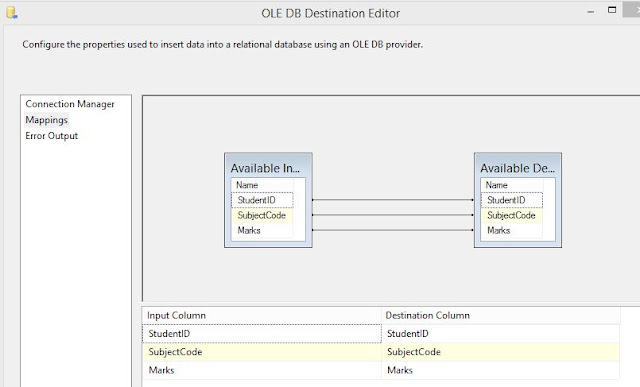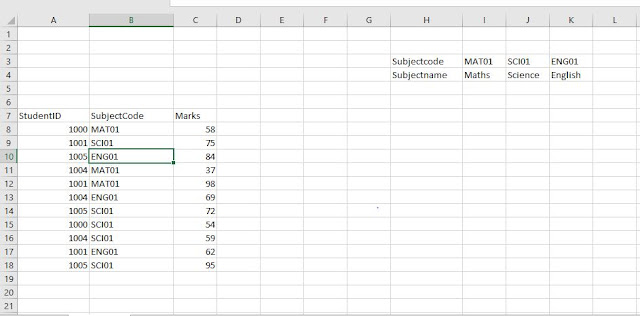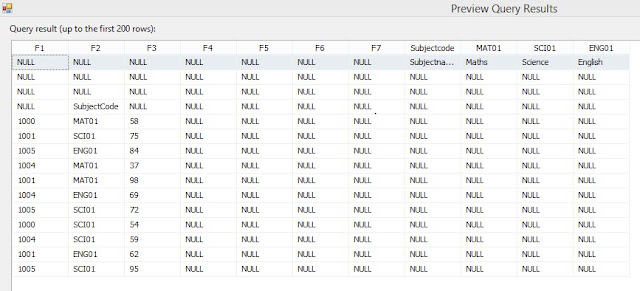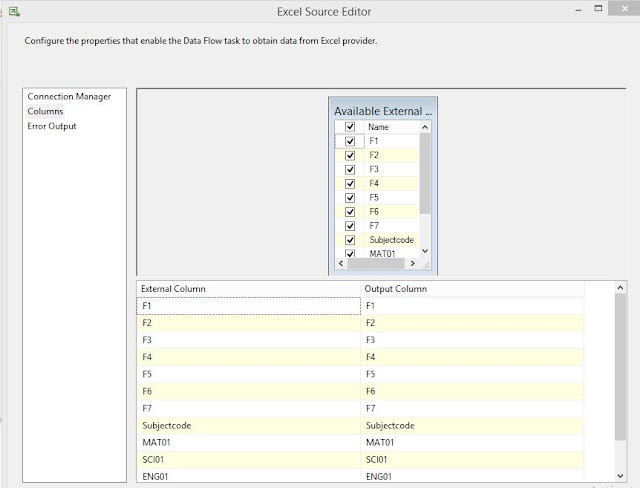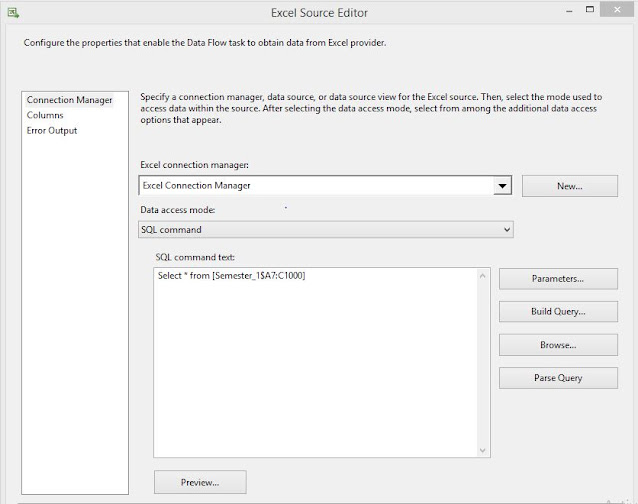In this blog we are going to discuss about how to load an
EXCEL file using SSIS and how to do various transformation to the EXCEL files.
1. Excel Loading
Example 1
As a start first we’ll see how to load a simple EXCEL file.
Now let’s load this EXCEL sheet into a database which
created in SSMS and see the result. Following steps will help to achieve that.
First we have to create a database in the SSMS where we create the destination tables. I named it as Marks_DB.
Then we have to use SSIS package to build the ETL part. So,
the ETL will look like below.
Tip 1: Tick “First row has column names” if you want to get
the first row which available data as column headers.
Tip 2: If it gives an error as "SSIS Excel Connection
Manager failed to Connect to the Source". Then installing 32-bit Microsoft
Access Database Engine 2010 Redistributable will help to resolve the issue.
Now let’s have a look inside the dataflow task.
In here we have to set up and connect a source and a
destination. Source is an Excel source and the destination is an OLE DB
destination.
Excel source will be configured as below.
We have to choose the EXCEL connection manager which we
created and the data access mode should be Table or view. Then select our EXCEL
file from the “Name of the EXCEL sheet” list.
Then we can select preview where we can see the EXCEL sheet output.
Then we have to close the preview query result and select
the columns from the EXCEL source editor.
Here we can see all the columns we going to extract from the Excel source file.
Then click ok and we done configuring the EXCEL source.
Now we have to configure the destination.
Finally, Run the package and after that we can see the destination in SSMS as below.
Example 2
Now let’s see how to load an EXCEL file with below structure. I have named this EXCEL sheet as “Semester_1”.
As you can see there are two tables in the same Excel sheet. We have a vertical table and a horizontal table. We will first look in to the vertical table in this example and name the vertical table as Marks.
If we try to load the about EXCEL sheet as we did in Example 1 we’ll end up getting an output like below.
As you can see in the above image this is not the exact
output we need.
To get the marks table as output we can follow two methods.
Method 1 – Data Access Mode as Table or view
After we setup the EXCEL source with the EXCEL sheet we’ll have a preview of source data like below.
Then go to the columns and you’ll see something like below.
Now click ok. Then right click and select properties of the EXCEL source and change the Open row set as below to define the EXCEL sheet area which we need to read.
Now we can do same as Example 1 to load the destination and the final destination output will look like below.
Method 2 – Data Access
Mode as SQL command
In this method after selecting the connection manager in the EXCEL source we need to change the Data Access Mode to SQL command and type the SELECT query with the EXCEL sheet and mention the area to consider as below.
Then we’ll get the preview and columns of the EXCEL source as below.
2. Load Multiple EXCEL sheets into a single destination table
In this case I’m going to use an EXCEL source with SQL
command Data access mode.
Then the preview and Columns will be look like below.
After that we can create the destination and load the data.
Then the final output will look like below.
3. Loading EXCEL sheets with multiple tables and do analysis
For this section we going to use the EXCEL sheet given below.
As we discussed earlier we in this sheet we can see there
are two tables. One is vertical and the other is horizontal. We going to name
the vertical table as Marks and horizontal table as Subjects.
So, the idea is to map the Subject codes from Marks table
with Subject table and get the appropriate Subject name for each record in the
Marks table.
With usual method we can’t get the exact output which we
need, by load the two tables into two destination tables and join them. Because
it will be difficult to join a vertical table with a horizontal table.
So, we’ll be looking into a method where we can use an ETL
to solve this issue in an easy way.
Let’s start.
First we have to make the Subject (horizontal table) into a vertical
table.
To do that we need to add an EXCEL source inside the dataflow task. When creating the “EXCEL connection manager”, I will un-tick the “First row as column names”, because this a vertical table and if I don’t do that it will end up taking the table values as column names.
Then the preview and the columns will look like below.
As you can see in the columns I have renamed F1 as Category,
since that column is representing the column names which are Subjectcode and
Subjectname of our Subject table.
Then I’m going to connect a Unpivot tool to the EXCEL source.
I’ll configure the Unpivot table
as below.
I select the F2, F3 and F4 from the input columns and named the destination column as “Value” and Pivot key value column name as “Measure”.
If we load this data to a destination that output will look like below.
Now we are going to Pivot the out of Unpivot but before that
we have to sort the output of Unpivot.
After sort the Unpivot output it will look like below.
The important thing in about output is the “Measure” column. As you can see it maps the values between Subjectode and Subject name. For example, MAT01 and Maths from “Value” have same “Measure” as F2.
Then add a Pivot tool and configure it as below.
Set Pivot key is “Category”, Set key is “Measure” and Pivot
value is “Value” and click ok.
By default, it sets only the “Measure” column which holds the mapping as pivot default output. With this mapping we going to create the Subjectcode and Subjectname as output columns. For that right click on the Pivot tool and go to Show Advanced Editor. After that go to Input and output properties and select Input columns in Pivot default input and get the LineageID of “Value” column. Then click the Pivot default output and you can see there is only “Measure” as output. Click on the Pivot default output and create columns for Subjectcode and Subjectname. Subjectcode and Subjectname columns should have “Value” column LineageID as Source column in Custom Properties. Then add the Pivot key values of Subjectcode as “Subjectcode” which is exactly as same as in the EXCEL sheet. Also do the same for subjectname as well.
Now if we get the result to a destination table we’ll get below output.
And then we need to follow the steps in the Excel loading Example
2, method 1 or method 2 to get the Marks table. After that we are going to use the
Merge Join tool to join the Marks table with the Subject table which we created
so far. But before that again we have to use Sort tool and sort the Subjectcode
column which is the common column for both Marks and Subject tables. After
configuring the sort tools, we have to connect the both tools output to the
Merge join tool. First we have to join the sort output of Marks table because we
are going to use left join to join the tables and the left table should be the
Marks table. After connecting the Marks table select the Merge join left input from
the Merge join tool and then connect the sort output of Subject table.
Next double click on the merge tool again and choose the final output columns you need. In this case I choose StudentID, Subjectcode, Subjectname and Marks as below.








